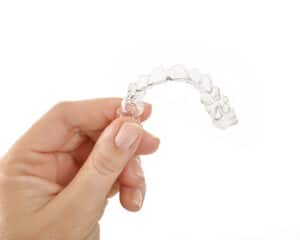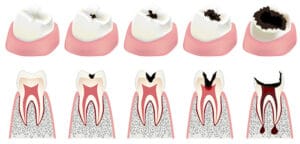Dental Services
Prevention & Cleanings
Dental examinations are essential to your oral health and only your dentist can perform them. A dental examination can spot problems early, before you even see or feel them and when they are much easier and cheaper to treat. The dentist examines your mouth for things that can affect your oral and overall health. Many of these are things you can’t see yourself, but the dentist is trained to detect.
Plaque is a natural substance that exists on the surfaces of teeth. Bacteria cause plaque to stick to the teeth and food particles will harden it and form tartar. Once formed, plaque and tartar irritate the gums and can become inflamed, irritated and infected with gingivitis.
Brushing and flossing regularly can remove plaque which will turn into tartar. However, once formed, tartar is too hard and firmly attached to be removed by simply brushing or flossing. A professional teeth cleaning, also known as a prophylaxis, is a process to remove tartar and a preventive treatment for the disease. Schedule your next cleaning and exam to keep your teeth and mouth healthy.
Dental Implants
With the placement of dental implants, we are not only able to add bone to the jaw, but we are also able to maintain the existing jaw bone. This is a very important feature of implants, they retain the shape and strength of your jaw. Anyone can get dental implants, however, you must have enough bone to receive the implants and be in good general health. Contact us for a consultation to assess if you are a good candidate for dental implants.
Teeth Whitening
 Restore the natural colour of your teeth! Teeth become darker with age and can become stained by certain foods, tobacco and drinks such as coffee, red wine and tea. The oxidising agent of peroxide penetrates the pores of the tooth enamel and breaks down the stain deposits in the dentin. Tooth whitening cannot be recommended for everyone. Contact us for a consultation to assess whether you are a good candidate for teeth whitening.
Restore the natural colour of your teeth! Teeth become darker with age and can become stained by certain foods, tobacco and drinks such as coffee, red wine and tea. The oxidising agent of peroxide penetrates the pores of the tooth enamel and breaks down the stain deposits in the dentin. Tooth whitening cannot be recommended for everyone. Contact us for a consultation to assess whether you are a good candidate for teeth whitening.
At Regency Dental Clinic, we recommend the take-home system because it produces beautiful results, which last longer and you can touch up yourself at six-month or one-year intervals depending on your needs. The advantage of the at-home treatment is that it is less expensive, uses less harsh products and lasts longer.
Dental Crowns and Bridges
When your tooth is severely decayed, has a large filling, or is fractured or cracked, it loses strength and support. It will take more than a dental filling to save the tooth, a dental crown will then be recommended.
Periodontal “Gum” Treatment
Periodontal disease, also known as gum disease, is caused when bacteria in plaque builds up between the gums and teeth and later forms calculus “tartar”. When the bacteria and calculus begin to grow, the gums surrounding the tooth can become inflamed. If left untreated, this inflammation can cause the gums and supporting bone structure to deteriorate. As the disease progresses, gums separate from the teeth forming pockets that become infected which can lead to tooth mobility and later tooth loss.
Gingivitis is the mildest form of periodontal disease. It causes the gums to become red, swollen, and bleed easily. Gingivitis is often caused by poor oral hygiene. Gingivitis is reversible with professional treatment (I.e. dental cleanings) and good oral hygiene routine. If left untreated, gingivitis can advance to periodontitis.
Most people are unaware they have this problem until it is too late as it is a silent and painless disease. This is why it is important to identify this problem early on as the probability of success is much better. Again that is why we also highly recommend regular dental cleanings and check ups as it is at these visits that 1) we help diagnose the gum disease and 2) we implement treatment methods to help stop and control this disease such as scaling and root planing and detailed home care.
Invisalign
Invisalign® is an alternative to a conventional orthodontic treatment and is used to correct mild cases of crooked teeth and protruding teeth, to much more difficult dental problems involving serious malocclusion, gapped teeth, overbite or underbite.

Invisalign takes a modern approach to straightening teeth, using a custom-made series of aligners created for you and only you. These aligner trays are made of smooth, comfortable and virtually invisible plastic that you wear over your teeth. Wearing the aligners will gradually and gently shift your teeth into place, based on the exact movements your general dentist plans out for you. There are no metal brackets to attach and no wires to tighten. You just pop in a new set of aligners every two weeks, until your treatment is complete. You’ll achieve a great smile with little interference in your daily life. The best part about the whole process is that most people won’t even know you’re straightening your teeth.
Choosing to straighten your teeth is a big decision that affects not only your appearance, but your lifestyle as well. As an adult, you may be looking to improve on your smile for business or social reasons. Invisalign can provide a simple way to accomplish this without having to put your life on hold. You’ve probably wanted to have straighter teeth for a while, but at this stage in your adult life, metal braces are not a choice you are willing to consider. Invisalign offers you the convenience and flexibility to live life without the hassle associated with other types of treatments. From the moment you start your Invisalign treatment, you’ll enjoy a better smile every day.
Dental Veneers
In today’s world, having a beautiful white smile has become so important as it implies health and youth. It enhances facial beauty and also has a direct impact on a person’s confidence.
Dental veneers are a cosmetic procedure that can esthetically improve a smile by placing a very thin tooth-colored porcelain or a composite resin shell (componeer) over the natural tooth’s surface to correct uneven tooth alignment, chips, cracks, discoloration, or unwanted spacing.

The ‘Hollywood’ smile is often achieved through placing anywhere from 6-10 veneers depending on the width of a person’s smile. Most people have them on the upper arch but they can also be placed in the lower arch.
Root Canal
When a tooth’s pulp becomes exposed to severe decay, bacteria, deep fractures from trauma/grinding, etc., the tooth may begin to die and develop an infection (abscess).

It might also become very painful. At this point, you only have two choices to treat the pain and infection. You can either remove your tooth or save it with a root canal treatment. A successful root canal treatment (also known as endodontic treatment) gives you the possibility to save your tooth rather than having it extracted. A root canal essentially is the removal of the damaged and infected tooth tissue from the tooth pulp chamber and roots. Your dentist will hollow out and clean the inner chambers and canals in the roots of the tooth. The dentist then fills the canals with a biocompatible material to prevent further infection.
Partial and Complete Dentures
Dentures are made up of acrylic pink removable plates that have teeth set in them to reproduce the missing teeth and healthy gums in a patient’s mouth. They need to be removed from your mouth to clean them properly. They are indicated in situations if you have suffered from severe gum disease, severe cavities or if you were in an accident and as a result have lost many or all your teeth. It may be a final treatment for you or a temporary one if you chose to have dental implants instead to replace your missing teeth. There are 2 types of dentures: partial and complete. For both types of dentures your dentist makes a model of your teeth by taking impressions. The models are then used to custom-make your dentures.
 Dental implants were first introduced for people who had lost all of their teeth. These people had great difficulty stabilizing or tolerating their dentures, largely because they had lost so much of the jawbone upon which their dentures rest. With the insertion of implants in their jawbone, the denture can now snap onto a special attachment on the implant that improves the stability and retention of the denture drastically.
Dental implants were first introduced for people who had lost all of their teeth. These people had great difficulty stabilizing or tolerating their dentures, largely because they had lost so much of the jawbone upon which their dentures rest. With the insertion of implants in their jawbone, the denture can now snap onto a special attachment on the implant that improves the stability and retention of the denture drastically.

As a result, this added to better chewing forces, which helped in better digestion. Not to mention an improvement in their level of confidence as well, due to the increased stability of the denture. Overall, research concluded a significant improvement in their quality of life.
Wisdom Teeth
Third molars or most commonly called wisdom teeth are the last teeth to erupt. They generally appear between the ages of 17 and 25. When they align properly, and gum tissue is healthy, wisdom teeth do not have to be removed. Unfortunately, in most cases this does not generally happen. When there is a lack of room to allow the teeth to erupt it results in a risk of periodontal disease and cavities in the wisdom tooth and also to the adjacent molar. The extraction of wisdom teeth is necessary when they are prevented from properly erupting. They may grow sideways, partially emerge from the gum, and even remain trapped beneath the gum and bone.

These poorly positioned impacted or semi-impacted teeth can cause many problems. When they are partially erupted, the opening around the tooth allows bacteria to grow and will eventually cause an infection. The infection usually causes swelling in the cheek and difficulty opening the jaw. The pressure from the erupting wisdom tooth may also move other teeth and disrupt the natural alignment of teeth. Removal of the impacted tooth or teeth usually resolves these problems. Early removal is recommended to avoid such future problems.
